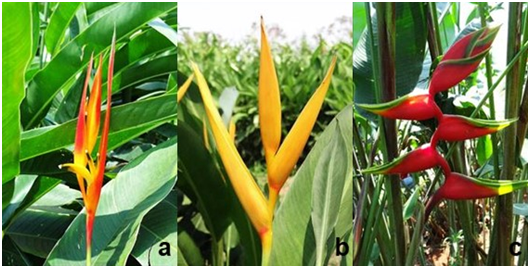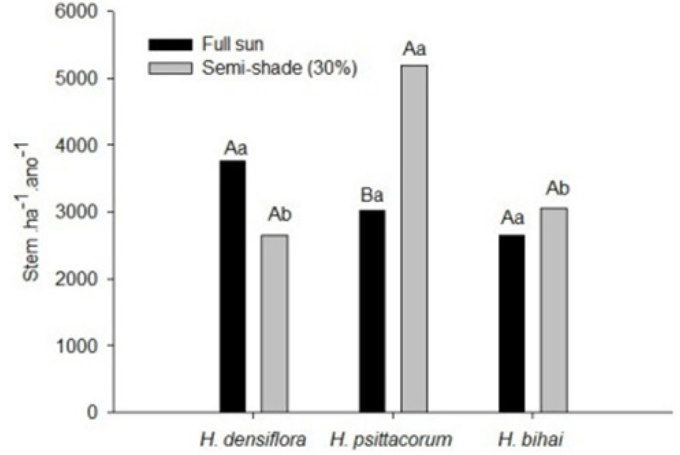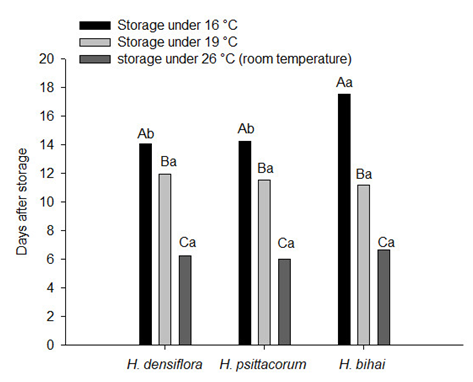eISSN: 2576-4462


Research Article Volume 4 Issue 4
Graduate Program in Genetics and Plant Breeding, State University of Mato Grosso, Brazil
Correspondence: Celice Alexandre Silva, Graduate Program in Genetics and Plant Breeding, State University of Mato Grosso, MT-358, 7- Jardim Aeroporto, Tangará da Serra, Mato Grosso, Brazil
Received: August 25, 2020 | Published: August 10, 2020
Citation: Botini AF, Cordeiro MHM, Krause W, et al. Productivity and durability of Heliconiaceae grown under different conditions and stored under refrigeration. Horticult Int J. 2020;4(4):139?142 DOI: 10.15406/hij.2020.04.00173
Heliconia (Heliconiaceae) species are widely commercialized by producers and consumers, due to the beauty and variety of shapes, colors of bracts, resistance to transport, and postharvest durability of their flowers stem. The purpose of this study was to evaluate the productivity and durability of bracts of three species of Heliconia spp., under different conditions of cultivation and cold storage temperatures. Heliconiaceae accessions cultivated in full sun and semi-shade were evaluated for the number of marketable stems produced and their postharvest durability under varying storage temperature conditions (16, 19, and 26 °C). Data from two years of cultivation were subjected to analysis of variance and Scott Knott's test. The productivity of flower stems was influenced by the growth conditions. H. psittacorum and H. bihai (Maluca) showed higher yields under shaded cultivation, while the highest productivity for H. densiflora was observed in full sun cultivation. Temperatures of 16 and 19 °C effectively prolonged the life of the flower stems. Shaded cultivation and refrigerated storage of Heliconia spp. are important methods to ensure successful cultivation and commercialization of these species, as they increase productivity and extend the useful life of flower stems.
Keywords: tropical flowers, postharvest, light intensity, shaded cultivation, refrigerated storage
As an economically important sector in agribusiness, production of flowers and ornamental plants in Brazil are gaining a prominent position.This sector shows high potential for further expansion, as it provides employment and income for micro and small producers across the country.1
Among the tropical flowers grown in Brazil, genus Heliconia (Heliconiaceae) is important to the ornamental plant market.2 Heliconiabihai, H. psittacorum, H. wagneriana, H. rostrata, and H. stricta are some of the most grown species in Brazil along with cultivars such as, H. psittacorum var. Golden Torch and Red Torch.3 Heliconia plants are widely preferred by producers and consumers alikefor their beauty, variety in shapes, colors of bracts, and postharvest durability of flower stems.4 However, there is a lack of information regarding development, planting systems, harvest and postharvest management, and the influence of these factors on the quality of these species.5 To efficiently produce and market these plants, factors such as choosing the appropriate species and varieties, availability of propagation materials and suitable structures for cultivation (climate control and planting system, fertilizers, and pest and disease management), as well as knowledge of production and postharvest techniques are essential.6
The objective of the present study was to evaluate the productivity and durability of Heliconia spp. in semi-shade cultivation and in full sunlight.
The experiment was carried out in the experimental area of the University of the State of Mato Grosso (UNEMAT), located in the municipality of Tangará da Serra - MT (“14º08'38" S and “57º03'45" W). The region has a tropical climate, and is at an altitude of 488 m with an annual rainfall of 1,830.8 mm. The dry season extends from June to August and the rainy season from October to April7.The soil is classified as Dystroferric Red Latosol with clay texture and flat to slightly undulating relief.17
The accessions of Heliconia densiflora, Heliconia psittacorum var. Golden Torch, and Heliconia bihai (Maluca) (Figure 1) were cultivated in two cultivation systems, fullsun, and semi-shade (30%). The plants were spaced at a distance of 3 × 3 m and irrigation through micro-sprinkling, with one microjet per clump.During planting, fertilization in the pit was carried out with 200 g of formulated N-P-K in the proportion of 3: 1: 2. During the following years, top dressing with 150 g. pit-1 of the formulated N-P-K in the proportion 15:15:15 were carried out every three months.2

Figure 1 H. densiflora (a), H. psittacorum var. Golden torch (b), H. bihai (Maluca) (c)in semi-shade cultivation. Tangará da Serra – Brasil, 2017.
The experimental design was set up in randomized blocks with seven replicates and one clump per plot, in a 3 × 2 m factorial scheme (accesses × environment), to evaluate productivity. Postharvest durability was evaluated in a triple factorial scheme, with three temperatures (16 °C, 19±3 °C, and 26±3 °C), three accessions, and two cultivation environments. Four replicates of 10 stems per plot were used. A cold chamber was used to store plants under temperatures of 16°C and 19±3 °C with a relative humidity of 80%. The flower stems were maintained in the laboratory at atemperature of 26±3°C and a relative humidity of 50%.
The flower stems were harvested weekly between 0700 and 0800, during the two years of production. After harvesting, the flower stems were taken to the postharvest shed where the number of marketable stems was separated by counting the number of stems that had a commercial pattern (flower stem length greater than 80 cm, diameter of 1–3 cm, and devoid of damage). Using the marketable stems data, flower stem productivity was calculated at ha-1. year-1.
Postharvest durability was evaluated from the packaging of marketable flower stems in buckets containing clean water and later stored under refrigeration (16°C, 19±3°C, and ambient temperature of 26±3 °C), until the point of disposal. Visual assessments were carried out every day, and when the flower had lost its brightness, dark spots appeared on the inflorescence, or when slightly spotted bracts were visible, the flower stem was discarded.
Statistical analysis was performed using the Sisvar® statistical program.8 Data were subjected to analysis of variance and the means compared using Scott-Knott test at 5% probability.
The productivity of H. densiflora and H. psittacorumvar. Golden Torch was influenced by the culture environment (Figure 2). With respect to H. densiflora, the highest productivity was observed in full sun cultivation (3753.97 stems.ha-1. year-1) and on average, was 41.20% higher than that observed in shaded cultivation. In contrast, H. psittacorum var. Golden Torch in semi-shade condition showed higher productivity (5198.41 stems.ha-1. year) than that observed under full sun cultivation (was 3023.80 stems. ha-1. year-1) (Figure 2).

Figure 2 Annual productivity of flower stems of Heliconiadensiflora, H. psittacorum var. Golden Torch, and H. bihai (Maluca) cultivated in full sun and semi-shade (30%). Uppercase letters compare the cultivation conditions and lowercase letters compare the species evaluated by the Scott-Knott test at 5% probability. Tangará da Serra - Brazil, 2017.
Cultivation environments did not influence the productivity of H. bihai (Maluca), which did not show significant differences between productivity under full sun (2658.72 stems. ha-1. year-1) and that in semi-shade (3055.55 stems. ha-1. year-1) (Figure 2).
Under full sun cultivation, no significant differences in terms of productivity were observed between the species evaluated. However, under semi-shade cultivation, H. psittacorum var. Golden Torch stood out from the rest with a productivity of 5198.41 stems. ha-1. year-1.
Postharvest durability differed significantly between species and storage temperatures; however, with respect to the cultivation environments, no significant differences were observed by analysis of variance. The temperature of 16°C provided durability posthaverst of 17 days for the specie H. bihai (Maluca) and differing significantly from H. densiflora and H. psittacorum that had durability of 14 days (Figure 3). Ats temperatures of 19 and 26°C, no significant differences were observed to postharvest durability between species. The general postharvest durability average of flower stems at these temperatures was 11.57 and 6.27 days, respectively.

Figure 3 Days of storage of flower stems of Heliconiadensiflora, H. psittacorumvar. Golden Torch, and H. bihai (Maluca) stored at temperatures of 16 and 19 °C in a cold chamber and 26 °C in an ambient condition. Uppercase letters compare the species evaluated and lowercase letters the storage temperatures by the Scott Knott test at 5% probability. Tangará da Serra - Brazil, 2017.
Symptoms of physiological disturbances caused by cold (chilling) during storage at temperatures 16 and 19 C were not observed. The flower stems, regardless of the storage temperature, showed bracts with loss of luster and turgidity and brown spots on the extremities at the time of discard.
Cultivation environment influences the productivity of Heliconia spp. In general, commercially viable flower stems are usually obtained from shaded crops. Crops grown under shade show intense colors and less damage than is caused by cultivation by direct sunlight. Under full sun cultivation in certain regions of the country, such as in the northern coast of the State of São Paulo and Pernambuco, the stems may show burns on bracts and reduces the number of marketable stems.3
In literature, it is reported that under shading conditions of approximately 36%, H. psittacorumvar. Golden Torch shows higher flower stem productivity.9 This result corroborates with findings of the present study, where under a shading of 30%, the productivity was almost twice as much as that observed in full sun cultivation.
Although no significant difference was observed, the productivity of H. densiflora under cultivation in full sun was higher than that observed in semi-shade environment, which may suggest that the direct light intensity results in a higher flower stem productivity for these species, due to an increased photosynthetic activity.
The postharvest durability of small heliconia, such as H. densiflora and H. psittacorum var. Golden Torch, is influenced by several factors such as stage of development, harvest time, and postharvest storage temperature.10 For tropical flowers, the recommended storage temperature varies between 7 and 15 °C.11 Very low temperatures can cause cold injuries (chilling), inducing symptoms such as discoloration of flowers and necrotic lesions on petals and leaves.12
Cold storage with temperatures of 16 and 19 °C prolonged the life of the flower stems when compared to storage at 26 °C. These results corroborate those found in literature, where it was reported that cold storage prolonged the useful life of heliconia.13–15 Low temperatures reduce the rate of transpiration, ethylene production, and respiration; factors that influence the senescence of plant organs.16
In a previous study, it was reported that H. bihai stored at 19 °C showed a postharvest durability of 14 days.13 In the present study, under the same storage temperature, the average durability of the species was found to be 11 days. Addition to the storage temperature, other factors can influence postharvest durability of flower stems,10 such as cultivar, harvest stage, and environment conditions during cultivation.
Temperatures as low as 7 C can prolong the life of tropical flowers after harvest.11 without affecting the quality of the flower stems. In our study, 16°C was the most efficient in extending the durability of the flower stems, regardless of the species evaluated.
Determining a storage temperature that prolongs the useful life of these flowers, without causing damage to the final quality of the product is essential for strengthening the productive chain of tropical flowers, as greater durability will enable to market these flowers in distant markets. In this study, we found that under lower temperature (16 C), the useful life of these flowers was extended by twice the period of those in ambient conditions.
The productivity of flowering stems of H. densiflora, H. psittacorum var. Golden Torch, and H. bihai (Maluca) was influenced by the cultivation environment. H. psittacorum var. Golden Torch and H. bihai (Maluca) showed higher yields under shade cultivation, while H. densiflora, showed higher productivity under full sun cultivation.
Low temperature storage effectively prolonged the useful life of flower stems of the three species evaluated, and storing flower stems in a temperature of 26°C is not recommended due to rapid deterioration of inflorescence. The durability of the flower stems stored at 16 and 19°C was 10 days longer than that at 26 °C.
The authors would like to thank the Coordination for the Improvement of Higher Education Personnel (CAPES), National Council for Scientific and Technological Development (CNPq), Foundation for Research Support of the State of Mato Grosso (FAPEMAT), and State University of Mato Grosso (UNEMAT) for their financial support, study grants and provision of infrastructure.

©2020 Botini, et al. This is an open access article distributed under the terms of the, which permits unrestricted use, distribution, and build upon your work non-commercially.